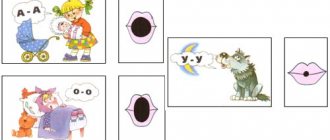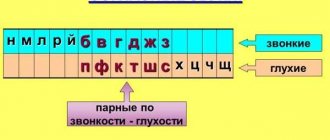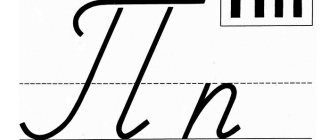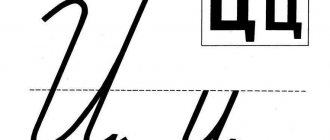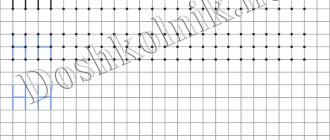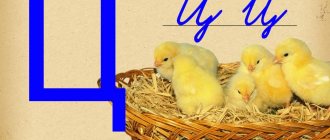As you know, the Russian alphabet includes 33 letters. Moreover, it is necessary to distinguish the concept of “letter” from sound. A letter is what we write and see, and a sound is what we hear and pronounce.
Of the 21st consonant letters, two (these are “b” and “b”) have no sound equivalents. Others are divided into several categories based on sounds, one of them being hissing ones. From the first grade, everyone learns a simple rule about them: “zhi” and shi” are written with “i”, “cha” or “sha” is written with “a”, and the combinations “schu” or “chu” with “u”.
Classification of sounds in Russian
The phonetics of the Russian language includes vowels and consonants, indicated in writing by certain letters.
key vowel sounds that are under stress:
- A;
- U;
- ABOUT;
- E;
- Y;
- AND.
Since there are more consonant sound formations in the Russian language, they are classified according to the following criteria:
- method of education;
- place;
- according to the degree of participation of noise and voice.
If we talk about the ratio of noise and voice during the formation of consonants , then the classification looks like this:
- sonorants and their soft pairs (p, m, l) and “th” without a pair;
- noisy (voiced and unvoiced);
- hissing (sch, h, sh and zh).
In this case, Zh and Sh are always hard, and Ch and Shch are only soft.
Lessons on making the sound “sh”
A child's education cannot be achieved without play. First you need to check your attentiveness and clarity of perception. Say words with and without the letter “sh” in any order. Invite your child to clap his hands when he hears words that contain the sound “sh”.
Be sure to praise your child for his successes.
Ask your child to use his hand to depict a hissing snake, which must follow the drawn labyrinth to the goal.
Remember together where else you can hear hissing sounds - the rustling of fallen leaves under your feet, the hiss of a cat, the rustle of a frightened mouse, the rustling of leaves in the wind.
To reinforce the sound, first use syllables and words, and then tongue twisters, children's poems and pure tongue twisters. Pictures depicting objects that have the letter “sh” in their names will be of great help in automating pronunciation.
You need to start learning the correct pronunciation of the sound “sh” with articulation exercises. Then, with the help of games and activities, you can consolidate the achieved result.
Features of hissing sounds
Sibilants have their own characteristics when pronounced . So, you need to tighten your lips and move them forward a little. They cannot be pronounced with closed lips, unlike some others (for example, M). The tip of the tongue is slightly pressed against the palate with its edges, leaving a small space in the center of the tongue. It is through this that the air passes, creating a hissing sound when pronounced.
Initially, hissing consonants were soft in the Old Russian language. They appeared as a result of the first palatalization, or when the combination of consonants with [gj], ['zj] and other sounds changed.
The initial softness of these sounds determined the fact that in many literary monuments the letters that denoted them were pronounced followed by vowels or “ь” , for example:
- husband;
- nessshi;
- hour;
- comfort, etc.
However, in the process of the formation of linguistic norms and adverbs, [w] and [zh] hardened, but “ch” still remained soft. The hardening of [w] took place around the 14th century. At this time, variants of writing the sounds [w] or [zh] with the letter “s” after them appeared in literary monuments. For example, “Shyshkin” or “hold.”
In modern language, it is traditional to write a soft sign at the end or the letter “and” to indicate the sound [s] in words such as:
- disturb;
- sew;
- fat;
- rye, etc.
Combinations such as soft [schtsch] or [zhj], which were common in antiquity, then lost the explosive element in such combinations in words such as “I’m looking for” or “yeast.”
Pronunciation check
Parents can check the correct pronunciation of sounds by their child themselves.
There are different tests for this. You can use the same technique with which speech therapists evaluate a child’s speech at the first appointment: ask to pronounce words or syllables containing hissing sounds (for example, noise, school, came, bumblebee). To pronounce W correctly, the tongue should be like a ladle, located in the center of the oral cavity, and not stick out forward. It is important that the tip points upward.
The verification should be carried out in stages:
- The first stage is a general check. You need to ask the child to say a couple of easy sentences that contain words with a letter (for example, “you should wear a scarf in winter,” “the cat caught the mouse”). Next, you need to move on to the pronunciation of individual words (edge, hat, good, porridge);
- the second stage is checking the sound of Ш in isolation. Attention is paid to syllables. You need to ask the baby to say “OSH”, “SHA”, “OSHO”, “USHU”. This will allow you to find out how well the child can pronounce sounds. It happens that such a check reveals problems with vowel sounds. Therefore, it is recommended to vary the syllables;
- the third stage is testing in individual syllables with voiceless and voiced consonants.
To check the pronunciation of different sounds, there are special cards with bright pictures. They are sold in children's stores. Thanks to such cards, the test can be carried out in the form of an enjoyable game.
Sample tasks on the topic of sibilant consonants
A teacher who will conduct a lesson for first-graders on this topic should set himself the following tasks:
- he is obliged to create conditions for children to learn the concept of hardness and softness of consonants, for example, that “zh” and “w” are always hard;
- teach students to correctly formulate writing skills;
- develop their written and coherent oral speech;
- use new information technologies when teaching.
After the teacher explains the essence of the lesson, he can write several letters on the board (B, L, CH, K, R).
Then the question is asked which of the letters presented does not denote any sound, and the correct answer is b. You can also ask students to find the letter for the hissing sound.
Next, we suggest working with a textbook of the following nature:
- children are asked to take turns reading the text (the skill of reading aloud is improved);
- we select some words and invite the children to explain their meaning (at the teacher’s choice);
- offer to find those words that contain letters denoting hissing consonants;
- Have them say them out loud and write the letters on the board.
The next part of the lesson is to work with images . Hang pictures on the board and ask students questions:
- what objects are shown in the pictures;
- what names contain hissing sounds;
- Which of the listed sizzlers are hard and which are soft.
Interesting poems for children about the letter “SH”
The letter Ш is very simple, like a fence, straight, but it hisses, makes noise, rustles, speaks with a lisp, as if two teeth had fallen out, how will I teach it?
Author: Anoshina V.
∞∞∞∞∞∞∞∞∞∞∞∞∞∞∞∞∞∞∞∞∞∞∞
The letter Ш bought balloons and decided to fly on them.
Author: Krasnikova I.
∞∞∞∞∞∞∞∞∞∞∞∞∞∞∞∞∞∞∞∞∞∞∞
The letter Ш is for mice. Mom will knit hats for Shatkas and sew three hats, so that the ears do not freeze.
Author: Zelenaya K.
∞∞∞∞∞∞∞∞∞∞∞∞∞∞∞∞∞∞∞∞∞∞∞
Letter Ш - Hissing, Sometimes - Rustle, Often - Rustle, Occasionally - Squeak.
Author: Ivanov S.
∞∞∞∞∞∞∞∞∞∞∞∞∞∞∞∞∞∞∞∞∞∞∞
Look carefully, think slowly, and you will definitely find Six things starting with the letter Sh!
Author: Shibaev A.
∞∞∞∞∞∞∞∞∞∞∞∞∞∞∞∞∞∞∞∞∞∞∞
I'll ask the kid: “What do we have that starts with the letter Sh?” He will answer: “I know, dad - School, Balls and Hat.”
Author: Manfish A.
∞∞∞∞∞∞∞∞∞∞∞∞∞∞∞∞∞∞∞∞∞∞∞
Don’t wake up the baby, - the letter Ш whispers quietly, - Don’t rustle in the house, Mice, - Don’t disturb the baby’s sleep.
Don't make noise, Winds, in the thicket - Our children are resting. In the morning, Sun, don’t rush - The kids are watching fairy tales, Sh-Sh-Sh...
Author: Garg T.
∞∞∞∞∞∞∞∞∞∞∞∞∞∞∞∞∞∞∞∞∞∞∞
How good and useful is the Letter Ш! Without it, you won't even feed your baby porridge.
You won’t go, you won’t go, you won’t eat or drink, you won’t play the harmonica and you won’t sing ditties.
If you can't sew a hat, hurry up and make him laugh! Well, let's take our time, We'll write the letter Sh!
Author: Manzhos N.
∞∞∞∞∞∞∞∞∞∞∞∞∞∞∞∞∞∞∞∞∞∞∞
A naughty Chimpanzee named Tishka jokes with us. He pulled the scarf off the hanger and dropped the hat under the chair.
Author: Punko N.
∞∞∞∞∞∞∞∞∞∞∞∞∞∞∞∞∞∞∞∞∞∞∞
The letter Sha hisses with a hiss, Sha rustles with a rustle, She barks in the closet with a mouse, She scurries across the roof with a cat.
Author: Melnik N.
∞∞∞∞∞∞∞∞∞∞∞∞∞∞∞∞∞∞∞∞∞∞∞
She sews with a huge sharp awl, warm fur coats ShinShilla. ShinShilla sews from the heart, fur coats are very good.
Author: Smiles D.
∞∞∞∞∞∞∞∞∞∞∞∞∞∞∞∞∞∞∞∞∞∞∞
The playful white bear took off his hat and took off his pants, untied his warm scarf - he skipped school twice.
Author: Lavrova T.
∞∞∞∞∞∞∞∞∞∞∞∞∞∞∞∞∞∞∞∞∞∞∞
The silkworm spins silk for everyone, the bumblebee sews an outfit from silk. The silkworm spins silk, the mulberry thread scurries.
Author: Marshalova T.
∞∞∞∞∞∞∞∞∞∞∞∞∞∞∞∞∞∞∞∞∞∞∞
Bumblebee soiled Pants, Bumblebee washed Pants. While his pants were drying, he slept soundly in the hut.
Author: Tselishchev S.
∞∞∞∞∞∞∞∞∞∞∞∞∞∞∞∞∞∞∞∞∞∞∞
Shu-shu-shu - the mouse rustled, Shu-shu-shu - the reeds rustled, The nimble little woodpecker, Husking the sixth cone.
What's that noise? Ears can hear, Someone is breathing louder, louder, Someone is waving higher, higher, Someone is whispering: “Hush, hush.”
Author: Dergunova T.
∞∞∞∞∞∞∞∞∞∞∞∞∞∞∞∞∞∞∞∞∞∞∞
The snake hisses, hisses, hisses, has been learning the alphabet for six months, the poor thing is already tired, and only knows the letter - Sh-Sh-She.
Author: Chudinova N.
∞∞∞∞∞∞∞∞∞∞∞∞∞∞∞∞∞∞∞∞∞∞∞
HAT TO HAT says: “You look terrible!” Look - my fields are WIDE, like the earth. THE HAT WHISPERS in response to her:
You are good! No doubt, SHAWL, what is in the chest of drawers will outshine you with its beauty. Here the mouse from the closet rushes with a squeal: “I gnawed a hole in that SHAWL!”
Author: Tereshkova G.
∞∞∞∞∞∞∞∞∞∞∞∞∞∞∞∞∞∞∞∞∞∞∞
The rustling was barely audible, the reeds whispered to the fir trees: “The real noise of the powder is unobtrusive, good!”
Author: Dolgikh E.
∞∞∞∞∞∞∞∞∞∞∞∞∞∞∞∞∞∞∞∞∞∞∞
The cone fell on the bear, Bear thought: “Stupid!” And Shishka thought: - MiShka! You can't be offended by Shishka!
Author: Shusharina S.
∞∞∞∞∞∞∞∞∞∞∞∞∞∞∞∞∞∞∞∞∞∞∞
The chinchilla sewed a new fur coat for her little daughter, and for her naughty little son she just mended her pants.
Author: Ukhanova I.
∞∞∞∞∞∞∞∞∞∞∞∞∞∞∞∞∞∞∞∞∞∞∞
The mouse climbs into the closet on the sly. There is a bag and two pots in the closet. There is wheat and millet in pots, noodles in a bag. The closet is dark.
Author: Plokhikh I.
∞∞∞∞∞∞∞∞∞∞∞∞∞∞∞∞∞∞∞∞∞∞∞
The mice sewed a fur coat for Sasha, also for Misha, Ksyusha, and Masha. On the sixth day we sewed four fur coats for the kids.
Author: Polyakova L.
∞∞∞∞∞∞∞∞∞∞∞∞∞∞∞∞∞∞∞∞∞∞∞
The long-eared hats rustled, the long-eared hats rustled, the old women wrapped themselves in shawls and hats, the fur coat hissed: quiet-sh-e, quiet-sh-e, After all, Schubert's waltz is being performed on the roof! And the mice scurried, and the cats squinted,
And above were playful midges circling. And Darned Shar Pei* Woolen Socks, And Made Checkered Shorts Out of Melancholy, Pinned a Silky Curtain with a Spike, And Ate Chocolate, Shawarma and Castor Oil.
Author: Tsvetikova O.
∞∞∞∞∞∞∞∞∞∞∞∞∞∞∞∞∞∞∞∞∞∞∞
Baba Shura sewed a fur coat, a hat, a scarf, and pants for the bear, so that the bear would not freeze, and in the cold he would hide his nose in the hat.
Author: Lebedeva N.
∞∞∞∞∞∞∞∞∞∞∞∞∞∞∞∞∞∞∞∞∞∞∞
The mice sewed a wide woolen scarf for the cat Masha. Dashka the cat has three shirts and six fringed pants.
They sewed shawls into a dowry, putting them in a chest, so that the cats would not interfere with their mischief in the attic.
Author: Bird S.
∞∞∞∞∞∞∞∞∞∞∞∞∞∞∞∞∞∞∞∞∞∞∞
Shu-shu-shu - the mouse rustled, Shu-shu-shu - the reeds rustled, The nimble little woodpecker, Husking the sixth cone.
What's that noise? Ears can hear, Someone is breathing louder, louder, Someone is waving higher, higher, Someone is whispering: “Hush, hush.”
Author: Dergunova T.
∞∞∞∞∞∞∞∞∞∞∞∞∞∞∞∞∞∞∞∞∞∞∞
Was there a storm today? Or maybe a terrible squall, hitting a schooner at sea, tore the boats off the deck?
No, not at all, neither a storm nor a squall! Just a skipper, Taking the helm, Moored the schooner himself to the pier An hour ago!
Author: Shandra I.
∞∞∞∞∞∞∞∞∞∞∞∞∞∞∞∞∞∞∞∞∞∞∞
How fearless our baby heard the mouse in the silence. The mouse rustled - he went, found six mice in the closet.
Author: Vorobyova E.
∞∞∞∞∞∞∞∞∞∞∞∞∞∞∞∞∞∞∞∞∞∞∞
Schoolboy, schoolboy, you are a strong man: You carry the globe like a ball.
Author: Samuel Marshak
∞∞∞∞∞∞∞∞∞∞∞∞∞∞∞∞∞∞∞∞∞∞∞
Hats and scarves are very necessary. Hats and scarves are very important, So that the ears of a playful girl do not freeze.
Author: Goryunova I.
∞∞∞∞∞∞∞∞∞∞∞∞∞∞∞∞∞∞∞∞∞∞∞
Ball is a little puppy, but he couldn’t catch the red ball.
Author: Ditkovskaya I.
∞∞∞∞∞∞∞∞∞∞∞∞∞∞∞∞∞∞∞∞∞∞∞
Chocolate
Chocolate, simple in appearance, will expose everyone. Confess, be brave, Everyone can see WHAT you ate.
Author: Slutskaya L.
∞∞∞∞∞∞∞∞∞∞∞∞∞∞∞∞∞∞∞∞∞∞∞
Schoolboy, schoolboy, you are a strong man: you carry the globe like a ball. The Mouse and the Mouse The mouse whispers to the Mouse: “Are you rustling, you’re not sleeping!” The mouse whispers to the mouse: “I’ll rustle more quietly.”
Author: A. Kapralova.
∞∞∞∞∞∞∞∞∞∞∞∞∞∞∞∞∞∞∞∞∞∞∞
frogs
By the river, along the edge, past the plowed fields, lazy frogs walked to visit their grandmother.
Author: I. Demyanov.
∞∞∞∞∞∞∞∞∞∞∞∞∞∞∞∞∞∞∞∞∞∞∞
Mishka has bumps
Mishka threw the stick up. - Fall into the hat from the tree, big shot! A bump is a slap on the head. There were two cones at once.
Author: E. Petrischeva.
∞∞∞∞∞∞∞∞∞∞∞∞∞∞∞∞∞∞∞∞∞∞∞
Scarf
I was walking through the forest and was afraid... I came across someone’s scarf. Immediately the forest became less scary. - Hey, who lost the scarf?!
Author: G. Vieru.
∞∞∞∞∞∞∞∞∞∞∞∞∞∞∞∞∞∞∞∞∞∞∞
Cat car
A cat, a cat and six kittens want to go to Koshkino. The cats sat at the windows. Eight windows - eight cats.
They ask the conductor for eight bowls of milk. The guide Woof-woof is embarrassed. No dogs allowed!
Author: A. Stroilo.
∞∞∞∞∞∞∞∞∞∞∞∞∞∞∞∞∞∞∞∞∞∞∞
A mouse is like a mouse A mouse is like a mouse, Just as big as an inch! The mouse climbed onto the bag.
She called the mice to her place. Let them rustle with grains! Let's rustle! Only the cats got in the way...
Author: G. Lagzdyn.
∞∞∞∞∞∞∞∞∞∞∞∞∞∞∞∞∞∞∞∞∞∞∞
Rustle, whispering, noise under the window, light padding... Who is this gnome? Shhh! There, behind the curtains, near the window, the silence rustles like a nimble mouse.
Author: V. Lunin.
∞∞∞∞∞∞∞∞∞∞∞∞∞∞∞∞∞∞∞∞∞∞∞
I'm redundant. They dug up the cherries. Sergei said: “I’m superfluous.” Five trees, five guys.
I went out into the garden in vain. And as soon as the cherries are ripe, Seryozha runs into the garden. - Well, no, now you’re superfluous! - The guys are talking.
Author: A. Barto.
∞∞∞∞∞∞∞∞∞∞∞∞∞∞∞∞∞∞∞∞∞∞∞
In our apartment. There are countless children on our stairs: Katya, Misha and Sasha, and Mashenka. Two Petyas live on the second floor. Another third lived there, but he had already grown up.
And the kids are growing up in our apartment. There are four beds - there are four of them here. Four coats and eight galoshes... You won’t find friendlier kids anywhere!
Author: Z. Alexandrova.
∞∞∞∞∞∞∞∞∞∞∞∞∞∞∞∞∞∞∞∞∞∞∞
About the big baby.
The reeds do not rustle in the river, and the mouse does not rustle under the floor. It's so quiet at this hour! Just hear:
- Sleep, baby. Near the big hut, the Elephant is rocking the baby, and the mother is in no hurry
She sews a fur coat for the baby. On a wide mossy stump he sews and flogs in the moonlight... It will be a good fur coat
big baby! I’ll write about the fur coat, but first I’ll ask the elephants: “How much fur did you buy for the baby’s fur coat?!”
Author: I. Demyanov.
∞∞∞∞∞∞∞∞∞∞∞∞∞∞∞∞∞∞∞∞∞∞∞
Grandmother
Our grandmother has enough worries: she knits and sews for Tanya and Natasha. “He reads books to them, sings to them before bed, and takes the kids for walks in the evening.”
Author: 3. Alexandrova.
∞∞∞∞∞∞∞∞∞∞∞∞∞∞∞∞∞∞∞∞∞∞∞
Baker
I mix sand with clay like flour. I bake on a hot stone for dinner:
a pretzel for the nesting doll, flatbread for the clown, gingerbread for the bear, and gingerbread for the bunny.
Author: G. Ladonshchikov.
∞∞∞∞∞∞∞∞∞∞∞∞∞∞∞∞∞∞∞∞∞∞∞
Shy reeds
I sit and listen, without breathing, to the rustling sounds of the reeds. The reeds whisper: “Shi, shi, shi!”
What are you whispering quietly, reeds? Is it good to whisper like that? And in response there was a rustling sound: “Sho, sho, sho!”
I walk along the shore and shout: “I don’t want to whisper with you!” I will sing and dance over the river! I won't even ask permission!
I'll dance right next to the reeds! The reeds whisper: “Sha, sha, sha!” As if they are asking in a whisper:
- Don't dance! How shy the reeds are!
Author: V. Orlov.
∞∞∞∞∞∞∞∞∞∞∞∞∞∞∞∞∞∞∞∞∞∞∞
- Sparrow, what are you waiting for? Don't you eat bread crumbs? “I noticed the crumbs a long time ago, but I’m afraid of an angry cat.”
Author: A. Taraskin.
∞∞∞∞∞∞∞∞∞∞∞∞∞∞∞∞∞∞∞∞∞∞∞
My new dress has pockets. These pockets have daisies embroidered on them. Daisies, daisies - like meadow ones. Daisies, daisies - just like alive.
Author: M. Plyatskovsky.
∞∞∞∞∞∞∞∞∞∞∞∞∞∞∞∞∞∞∞∞∞∞∞
Our playful Pavlushka! The baby will gut the pillow! Both the shirt and the pants are all covered in fluff on the baby!
Author: I. Lopukhina.
∞∞∞∞∞∞∞∞∞∞∞∞∞∞∞∞∞∞∞∞∞∞∞
Hat, mittens and fur coat, Buckle, strap, pants... So wrapped up - even your lips are not visible from under the scarf!
Author: I. Lopukhina.
∞∞∞∞∞∞∞∞∞∞∞∞∞∞∞∞∞∞∞∞∞∞∞
Bumblebee sells balloons. The balls are so naughty! The balls rustle and burst into the sky, and the silken threads break.
Author: G. Sapgir.
∞∞∞∞∞∞∞∞∞∞∞∞∞∞∞∞∞∞∞∞∞∞∞
The bumblebee darted and rustled in the sage, the bumblebee made a terrible noise, he did so many things - he even woke up the hornet.
Author: A. Pudval.
∞∞∞∞∞∞∞∞∞∞∞∞∞∞∞∞∞∞∞∞∞∞∞
The autumn bushes rustle, the leaves rustle on the tree. The reeds rustle and the rain rustles and the mouse, rustling, hurries into the hole.
And there, six nimble little mice rustle quietly. But everyone around is indignant: - How noisy the naughty people are!
Author: A. Usachev.
∞∞∞∞∞∞∞∞∞∞∞∞∞∞∞∞∞∞∞∞∞∞∞
The bumblebee and the hornet lived noisily, They sewed fur coats, hats, and pants of unprecedented width on a sewing machine.
Author: V. Kozhevnikov.
∞∞∞∞∞∞∞∞∞∞∞∞∞∞∞∞∞∞∞∞∞∞∞
Shubeika hissed: quiet-Sh-e, quiet-Sh-e, After all, Schubert's waltz is being performed on the roof! And the mice scurried, and the cats squinted, and the playful midges circled above.
And Darned Shar Pei* Woolen Socks, And Made Checkered Shorts Out of Melancholy, Pinned a Silky Curtain with a Spike, And Ate Chocolate, Shawarma and Castor Oil.
Author: M. Pridorov
∞∞∞∞∞∞∞∞∞∞∞∞∞∞∞∞∞∞∞∞∞∞∞
“Sh” is such a naughty girl, It looks too much like a fence, They only strengthened it, That fence is the other way around.
Author: Iris Review
∞∞∞∞∞∞∞∞∞∞∞∞∞∞∞∞∞∞∞∞∞∞∞
The letter “Sha” is very simple, like a fence, straight, but it hisses, makes noise, rustles, speaks with a lisp, as if two teeth had fallen out, how will I teach it?
Author: Vera Antoshina
∞∞∞∞∞∞∞∞∞∞∞∞∞∞∞∞∞∞∞∞∞∞∞
I love SHASHLIK and CHOCOLATE, the more of them, the more I’m glad. It’s a pity that you can’t eat them together... Or should you still try it, friends?
Author: Vera Antoshina
∞∞∞∞∞∞∞∞∞∞∞∞∞∞∞∞∞∞∞∞∞∞∞
The hornet is a relative of the wasp, but everyone knows the wasp, the hornet is only larger than the wasp, and it stings more painfully.
Hornet nests are like paper, moisture is dangerous to them from rain, so he hides them in warm and dry hollows.
Author: Mikhail Metelev
Working with tongue twisters
Tongue twisters are an excellent warm-up for children , which perfectly develops their speech skills. In the educational process they are used in different ways, in particular, in the study of sibilant consonants.
Invite students to read aloud several tongue twisters in a row. Moreover, the first time this must be done slowly, and then gradually increase the rate of pronunciation.
Ask the children what hissing sounds they found in tongue twisters, whether they differ from each other, and what their main characteristics are.
While taking dictation , offer to write down one of them in your notebook and ask students to underline the hard (or soft) sibilants. Invite one of the students to do this at the board.
Partial written work was mentioned above. It can also include homework. Sometimes workbooks contain tasks where you need to insert missing letters into words that contain certain sibilants. They should be emphasized.
So, we looked at what hissing consonant sounds are, how they can be identified, and with the help of what tasks you can teach a lesson at school on this topic.
Why do you have problems pronouncing hissing sounds?
There are various reasons for incorrect pronunciation. Most often, the problem is caused by weakness of the tongue muscles - the organ, instead of rising up when pronouncing words with the letter Ш, lies at the bottom of the mouth.
Common problems with the pronunciation of hissing sounds:
- replacing Sh with T or the absence of a hissing sound in speech . For example, instead of the word “whisper” the child says “tepot”, and instead of “bear” - “mika”. This may be caused by impaired phonemic hearing or early age;
- replacing Sh with F. For example, a child says “fifka” instead of “bump.” This disorder is called labiodental sigmatism. The problem is a shortened hyoid frenulum, too active lip work, and impaired phonemic perception;
- replacing Sh with S. For example, a child says not “school”, but “skola”. This problem is called whistling sigmatism. It is caused by a violation of phonemic perception;
- lisp . It occurs if the tongue does not follow the shape of the ladle and is pushed between the lower and upper incisors, forming a gap. The air stream is scattered and weak when pronouncing hissing sounds;
- Instead of Ш, a squelching sound is heard . This problem is called lateral sigmatism. In this case, one of the corners of the lips is slightly pulled back or lowered. Sometimes the child has a slight displacement of the lower jaw to the right or left. In this case, when pronouncing the sound Ш, the air stream comes out along the edges of the tongue or goes sideways;
- Instead of Ш, snoring is heard. This disorder is called nasal sigmatism. In the presence of such a problem, the speech organs occupy a neutral position, the tongue is pulled deep into the mouth, its back is raised and connected to the soft palate, and the edges are lowered. The air stream passes through the nasal cavity. This happens when there is excessive tension on the back of the tongue.
How to teach children to distinguish between hard and soft consonants
The very first thing you need to teach your child: consonant sounds can be hard and soft, but not letters.
Typical mistake: Children confuse sounds and letters. We remember that a sound sounds, and a letter is an icon, it is written. A letter cannot be hard or soft; only a consonant sound can be hard or soft in pronunciation.
Sometimes children can easily learn to distinguish soft and hard sounds by ear. But it happens that this is difficult, and in this case signs will come to the rescue by which you can distinguish hard sounds from soft ones.
Options for incorrect pronunciation of the sound “SH”
Ideally, the sound “Ш” should be pronounced clearly and quite loudly (despite the fact that it is a voiceless consonant). Preschool children can change this sound in different ways in their speech. Speech therapists identify the following possible deviations:
- Interdental pronunciation. If the baby pushes his tongue forward too much, a lisp is heard in his speech (the sound “Sh” sounds like “F”).
- Nasal pronunciation (“Sh” turns into “X”) occurs when the root of the tongue rises to the hard palate and air passes through the gap between them.
- Whistling pronunciation (replacing “Sh” with “S”).
- The soft pronunciation (“Sh'” instead of “Sh”) occurs because the tongue is pressed against the lower front teeth.
- If the tongue rests on the upper incisors, a “T” sound is produced.
- Air flow may pass between the cheek and molars, resulting in a popping or squelching sound. The child accurately pronounces the sound “Ш” incorrectly if at this moment his cheeks swell.
Sometimes babies can pronounce the sound “Sh” quite clearly if their articulation organs are in the wrong position. Therefore, it is necessary to monitor exactly how the child produces sound.
Whistling sounds: where to start staging
Usually, the production of sounds begins with the phoneme C. The first stage is preparatory. The child needs to be shown a picture with sound. You can draw this phoneme, mold it, make it from scrap materials. Explain how the tongue is positioned when pronouncing C (the tip rests on the lower teeth). It is advisable not to say that you are learning the sound C; it is better to name the phoneme, for example, “cold wind”. Next, articulation gymnastics is carried out.
Articulatory gymnastics for producing whistling sounds (exercises by L.A. Komarova)
- “Smile”
- stretch your lips in a smile and hold in this position. The teeth are not visible. - “Fence”
- smile so that your teeth are visible. Fix the position of your lips for a few seconds. - “Chick”
- open your mouth wide. The tongue lies calmly in the mouth. - “Punish a naughty tongue” - open your mouth slightly, put your wide tongue on your lower lip and say “five-five-five...”.
- “Spatula”
- place a relaxed tongue on the lower lip. Place the “spatula” in your mouth, trying not to strain your tongue. - “Tube”
- stick out your tongue and try to bend its edges up to form a “tube”. Blow into the “tube”. - “Jam”
- slowly lick your upper lip with your tongue, then the lower lip in a circle. - “Brushing your teeth”
- using the tip of your tongue, “clean” the lower teeth from the inside (from left to right, from top to bottom). We make sure that the lower jaw is motionless. - “Watch”
- open your mouth, the corners are stretched. The tip of the tongue moves to the right - to the left. - “Snake”
- using a narrow tongue to try to “bite” the palm placed in front of the mouth. The tongue moves forward and retracts back. It is important not to touch your lips and teeth. - “Candy”
– lips are closed. The tongue rests in turn on the left cheek from the inside, then on the right. - “Football”
- build a goal from cubes on the table, put a cotton ball in front of the child. The wide tongue rests on the lower lip. Blow on your tongue with the sound F, trying to move the cotton ball. Make sure your cheeks don't puff out.
Be sure to do exercises to develop air flow. The simplest ones: blowing soap bubbles, blowing out a candle, blowing on a paper boat, blowing cotton wool off a table.
Methods for producing sound C
A well-placed sound C allows you to quickly correct the pronunciation of Z and C, as well as sibilant phonemes. To get C, you need to rest the tip of your tongue on your lower teeth, stretch your lips in a smile and blow. If you bring the back of your hand close to your mouth, you feel a cold stream of air (“cold wind”).
The first way to produce sound is by imitation. In front of the mirror, invite the child to smile, show his teeth (“fence”) and blow on the “fence.” The tongue lies below. You can also imagine that you are pumping the wheels of a car. Pretend with your child that you are pumping tires and saying “sssssssssssssssssssssssssssssssssssssssssssssssssssssssssssssssssssssssssssssssssssssssssssssssssssssssssssssssssssssssssssssssssssssssssssssssssssssssssssssssssssssssssssssssssssssssssssssssssssssssssssssssssssssssssssssssssss scale basis].
If it is not possible to produce sound by imitation, then we try the mechanical method. A roll stick, a cotton swab, or a child’s finger will help here (of course, you need to wash your hands beforehand). We ask the baby to open his mouth. Pay attention to the tongue: sometimes the back is arched upward. Gently press the tongue with a stick or your baby's finger to create a groove through which air should pass. The baby covers his mouth, while keeping his lips in a smile, trying to blow. It turns out “ssss.” For some time, the child can press down the tongue with a finger until he learns to maintain the correct articulatory posture.
Automation C
After the individual sound C has been consolidated, the stage of phoneme automation in the child’s speech begins. For all sounds, automation follows the same scheme:
The most relevant and useful information for modern parents is in our newsletter. We already have over 30,000 subscribers!
- in straight syllables (sa, so, su);
- in intervocalic position (asa, oso, usu);
- in reverse syllables (as, os, us);
- with a combination of consonants (one hundred, one hundred, one hundred);
- in words (sound at the beginning of the word, in the middle and at the end: garden, wasp, pass);
- in sentences (Sonya is sledding);
- in poetry and pure sayings (Sa-sa-sa - here a wasp flies);
- in spontaneous speech (retelling a text, describing a picture).
With successful production of C, it is not difficult to obtain the sound Z: you need to “connect” the ligaments.
Invite your child to “ring” like a mosquito. Raise your index finger up, make rotational movements and make a “z-z-z” ringing sound. It is important to show the baby the difference between S and Z. Place the child’s palm against your throat and say “ssss” - the throat is calm. Now say “z-z-z” - your throat trembles. Let the child do the same on himself. For the sound T, two phonemes T and S are needed. To begin with, we ask the baby to say “t-s, t-s, t-s” and gradually increase the speed of pronunciation until Ts is achieved.
Each delivered sound is processed according to the scheme described above. Then we teach the child to pronounce soft phonemes (S', Z'). When the whistling sounds have become established in the baby’s speech, we begin to introduce the hissing sounds.
How to check your child's pronunciation?
It often happens that the first to point out problems with a baby’s sound pronunciation are caregivers, teachers, or people who hear the baby speak for the first time. It is sometimes difficult for parents to notice the peculiarities of their child’s speech, since as a result of constant communication, we get used to the way the baby speaks. There are two ways to notice difficulties in pronouncing the sound “Ш” at home:
- Observation. This diagnostic option requires quite a long time and increased attention from adults.
- Exercises. Using various tasks (with gradually increasing difficulty levels), you can check how your child pronounces the sound “Ш”.
- Snake. Ask your baby to sound out the hissing sound of the snake (“sh-sh-sh-sh-sh”).
- “Repeat the syllables.” Start with combinations of two letters (“sha”, “shi”, “shu”, “ish”, “osh” and so on), then use combinations of three letters (“u-shu”, “a-sha”, “ e-she", "o-sho" and others). The most difficult combinations are with consonants (for example, “kshi”, “shka”, “shki”, “sshi”, “pshi”).
Pronounce all sounds clearly and with pronounced articulation. Children often pick up incorrect pronunciation from adults, so parents need to closely monitor the purity of their own speech.
- “Say the word.” For this exercise, you need to prepare cards in advance with images of objects known to the little ones, the names of which contain the sound you need. Examples of words: neck, hat, mouse, car, lily of the valley, cone, fur coat, galoshes, cat, rustles, rough, ball and so on.
- Phrases and sentences with the sounds “Ш”. This is the highest level of difficulty, since in order to pronounce sentences correctly, you need good articulation. Examples: “the cat is running after the mouse”, “Sasha was walking along the highway”, “a rough bump”, “Mom sewed me panties”, “Dasha put on a warm scarf”, “Misha splashes through the puddles”.
Examples of interesting tasks for developing the skill of distinguishing between soft and hard consonants
A picture or simply a list of thematic words is shown, and the task is given to choose words with soft or hard consonants. For example:
Exercises for the development of the speech apparatus
When pronouncing the sound “sh” correctly, the tongue should occupy a certain position in the mouth. It is spread wide, and the tip is raised towards the hard palate, and forms a gap with it behind the upper teeth. The lateral edges of the tongue are pressed against the upper incisors.
How to teach a child to say the letter “sh” at home - do tongue exercises with him
If the baby cannot pronounce the sound correctly, articulation gymnastics is needed. For home exercises, special exercises are used that train the speech apparatus. The child should perform them in front of the mirror to see how he can repeat what his mother shows:
- “fence” - the baby must close his teeth and show his mother what kind of “fence” he has made;
- “tube” - the child stretches his lips forward like a tube, then quickly alternates between the “tube” and “fence” exercises;
- “lazy tongue” - the tongue needs to be stuck out of the mouth and placed on the lower lip, completely relaxed;
- “bucket” - we bend the relaxed tongue up and place it behind the upper teeth, blow on it, which produces the sound “sh”.



